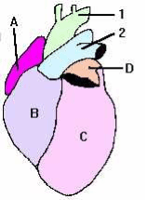
Figure 1. The main parts of the heart
The heart supplies the body tissues with oxygen saturated blood, it also ensures central heating and cooling and a number of other vital functions. If the heart fails to function death occurs within minutes.
The heart consists of muscle tissue and, as a contrast to most other organs in the body, it generates its own electrical impulses ensuring automatic function; pumping blood.
The heart has the following main parts:
A - Right ventricle
B - Left ventricle
C - Right atrium
D - Left atrium
1 - Aorta
2 - Pulmonary artery